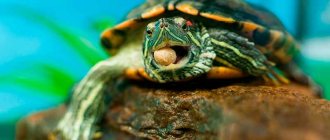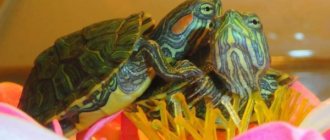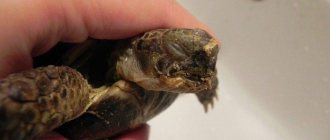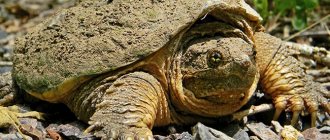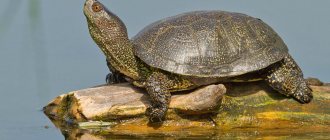One of the interesting varieties of turtles is the red-eared slider. This is a wild reptile that prefers small fresh water bodies to live. She is an amphibian because she loves to be on the shore. In addition, it needs proximity to land to lay eggs. It is worth finding out what is remarkable about this species of animal and what is characteristic of it.
Red-eared turtle - description and external characteristics
The red-eared turtle differs from other such reptiles by the presence of a red or orange stripe, which is located on the head - from the eyes to the neck. The top of the shell (carapace) has an olive-green tint. It is covered with lines of yellow and black colors. The plastron (bottom of the shell) is also smooth. Its color is yellowish with the addition of several dark inclusions. The younger the turtle, the brighter the color of its shell. Subsequently, it becomes darker, and the bright stripe on the head becomes pale.
The size of the animal can be determined by measuring the length of the shell. The bending of the shell is not taken into account, so it is most convenient to use a ruler. A small turtle that has just hatched is 2.5 cm long. By the end of the first year, individuals reach a length of 5-7 cm.
In red-eared turtles, males are smaller than females. The red-eared turtle grows throughout its life, and its average size is from 25 to 30 cm. This is influenced by the conditions of its existence, characteristics of care and, of course, gender.
By the size of a turtle you can determine its age. Although here you need to take into account that domestic turtles are larger in size than those that live in the wild, especially if they are provided with proper care.
The approximate sizes (in cm) of male and female individuals of different ages can be seen in the table.
| 1 year | 2 years | 3 years | 4 years | 5 years | 6 years | |
| Female | 6 | 9 | 14 | 16 | 18 | 20 |
| Male | 6 | 8 | 10 | 12 | 14 | 17 |
The rate at which a red-eared slider grows is greatly influenced by how it is kept. If a red-eared turtle lives at home and is given proper care and feeding, the pet will grow faster. But lack of knowledge about this often leads to death.
Hibernation
Hibernation is the period that a turtle enters during the winter months. There is no need for a pet turtle to hibernate! Moreover, it is not recommended! Never encourage her to do this.
Reasons why hibernation may be unsafe:
- you may not have enough experience to care for her at this time
- Most likely, in order for her to hibernate normally, you don’t have the conditions
- young and sick turtles may be too weak to survive the hibernation period
- your turtle may not need it at all
Turtles hibernating in nature burrow into leaves and silt at the bottom of a reservoir, the depth of which is shallow, and vice versa into the surface.
They do not rise to the surface during this time, but absorb oxygen through membranes in the mouth, pharynx and cloaca. In this case, the depth of the reservoir is important so that the water is not too cold, but also contains enough oxygen.
Most artificial conditions and ponds are unable to recreate these conditions.
In general, a pet turtle should not and should not be hibernated. By the way, the key condition here is the water temperature, it must be maintained at 24-26°C. Lower temperatures just remind her of winter and hibernation.
Sense organs
This animal is distinguished by a high level of development of sensory organs. The main features are as follows:
- Vision. Red-eared turtles distinguish colors, choose the most suitable places to lay eggs, and look for other turtles. They also see moving objects, the distance to which can reach 40 m, well distinguishing predators and prey from each other.
- Smell. These reptiles search for food thanks to their developed sense of smell.
- Hearing. These animals hear poorly. This is due to the fact that their ears are hidden under the skin. Therefore, red-eared turtles react only to vibration.
- Touch. The turtle's shell is equipped with nerve endings, so it feels touch. The presence of taste buds allows these creatures to choose tastier foods.
- Voice. The vocal apparatus of turtles is not developed; they are only capable of snorting and hissing. Sometimes they make a squeak.
Where does the red-eared turtle live in its natural environment?
The red-eared freshwater turtle is a resident of North America. The Mississippi River is called its homeland - these animals can be seen there most often. It prefers a warm climate, so it is common in the southern states of the United States. But at the present stage, this animal has spread throughout the world. In some areas its presence causes problems for local fauna.
The conditions in which the red-eared freshwater turtle prefers to live are characterized by the following features:
- warm fresh water,
- the presence of dense vegetation,
- weak current,
- islands of land or shore where you can bask.
Such turtles live in lakes, swamps and ponds - it is these reservoirs that satisfy their needs. They prefer the water's edge, without moving long distances from the shore. An adult red-eared turtle lays its eggs in hard ground.
Price
In the last century, businessmen appreciated people's desire to keep these animals at home. And in their homeland, in the USA, entire farms were created for raising young turtles. Now such enterprises operate not only overseas.
Decorative features, ease of maintenance and affordable prices have made these reptiles one of the most popular pets. The rules for choosing a turtle are simple. A careful external examination is sufficient. The shell of a healthy turtle has no peeling, scratches, dents or cracks. It should be smooth and hard.
A healthy turtle moves actively, does not fall on its side when swimming, there are no white spots on its paws and face, and the eyes of a red-eared turtle are not covered with a cloudy film. The price for the turtle is affordable. The main costs are associated with the purchase of an aquarium or terrarium, arrangement of a turtle’s home, and the purchase of high-quality food.
How long does a red-eared slider live?
The lifespan of a pet is a very important aspect that worries all owners. Therefore, when choosing such an animal, people are often interested in how long the red-eared turtle lives in the wild and at home.
Living in natural conditions, animals are in the environment most suitable for them. They eat properly, can move long distances, and interact with other individuals. Despite the presence of unfavorable factors, they feel comfortable. Therefore, this reptile is considered a long-liver. Although not everyone lives to old age. This is prevented by diseases, parasite infections, clashes with neighbors, attacks by predators, etc. In the wild, thanks to natural selection, the strongest individuals survive, which can reach the age of 40-50 years. But cases have been recorded when the animal lived to be 100 years old.
Subspecies
There are 13 subspecies of the red-eared turtle, but only 3 of them are the most famous and widespread:
Florida or Red-eared Slider
The dimensions of this main species, also known as Elegant, reach 30 cm, and its postorbital narrow stripe is reddish. All yellow abdominal plates have bright dark spots.
Yellow-bellied slider
Its plastron (abdominal shell) is more oval in shape, the plates are dark, with yellow spots and the same line along the edges.
Trusty or Cumberland species
This is the smallest red-eared turtle, its maximum size is 21 cm. The stripe behind the eyes is usually yellowish and narrow, and on the chin it is wide. There are patterns on the shell that resemble a scattering of black dots or peculiar eyes.
There are also interspecific hybrids.
What does the red-eared slider eat?
Being in their natural environment, red-eared turtles eat what is necessary for their full life. They are omnivores, so they eat both plant and animal food. At a young age, these animals need food of animal origin, so they actively hunt small fish, snails, insects, and tadpoles. Growing up, the reptile increasingly chooses plants growing in water bodies and coastal areas for food.
Natural habitat
It's wide enough. The red-eared slider can be found in many areas of the United States of America - Virginia, Florida, Oklahoma, Kansas, New Mexico, Arizona, North and South Carolina, Georgia, Alabama, Louisiana, Mississippi, Indiana, Illinois, Kentucky. In addition, this amphibian lives in Mexico, Colombia, Venezuela, and many other countries in Central and South America.
Currently, the yellow-bellied turtle has spread widely throughout the world. It can be found in Guadeloupe, Israel, Singapore, Vietnam, South Africa, Japan, Thailand, Malaysia, Hawaii, even in some European countries, such as Spain and England.
In Australia, the red-eared turtle is considered a pest, as it actively eradicates native flora.
In Russia, this species is already found in many ponds in the central part of the country, for example, in the Moscow region (Tsaritsynsky, Kuzminsky, Altufevsky, Dzhamgarovsky).
Thus, this amphibian showed high adaptability to new conditions and survival.
Reproduction
How ready an individual is for reproduction is determined by its size. The length of the carapace of a sexually mature male is 10 cm (it is typical for individuals 2-4 years old), females - 12-13 cm (age 2-5 years).
Mating games in these animals begin with the active actions of the male. He turns his muzzle towards the female, swims in front of her and waves his paws. This happens in March and June (if the turtles live in the wild). For a successful pregnancy, it is necessary to be warm. In addition, the female requires increased nutrition.
Shortly before laying eggs, the female looks for a secluded place to lay eggs. This is done on land. A few months later, babies hatch from the eggs. Usually this takes about 2 months, but in bad weather the period of formation of small turtles is delayed. The female does not look after the clutch and does not take part in the life of the cubs.
Nursing turtles
After the clutch is laid, the owner needs to transfer it to a special incubator. It could even be a simple three-liter jar of sand. The main thing is to carefully lower the eggs into it and place it in a warm place, for example, near a radiator. The main thing is that the temperature should always be constantly at +25…+30 °C.
Embryos develop in the egg for two to five months. It all depends on the temperature. If it is high, then the rate of turtle maturation increases, but only girls are born.
Males mature at low temperatures and take much longer.
After the babies hatch from the eggs, under no circumstances should they be transplanted into the aquaterrarium with adults in order to avoid cannibalism. They should be grown in a separate tank for at least a year.
Keeping a red-eared turtle at home
A pet such as a red-eared turtle is quite difficult, since it is difficult to organize the care required for it at home. She needs a large aquarium, shore decoration, temperature control, etc.
If you purchase a red-eared turtle, caring for it should begin with the purchase of an aquaterrarium measuring 150-200 liters. This is necessary even if the pet is small - because turtles grow. You need to pour enough water into the aquaterrarium so that the reptile can roll over in it. The water should not be allowed to be colder than 20 degrees, although the optimal temperature is 22-28 degrees. The water should be changed at least once a week, and the less it is, the more often it should be done.
An artificial island should also be created. You can buy it in the store - it will be easier. But you can do it yourself by choosing a non-toxic material without sharp corners.
The volume of the island must be at least 25% of the territory. It definitely needs heating. Its surface should be 10 degrees warmer than the water. Its stability is also important so that the reptile does not turn it over.
You can heat the aquaterrarium using a lamp. It should be placed above the shore, but not too low so that the pet does not get burned. Be sure to hang up a thermometer and monitor its readings. The lamp should be placed so that it is not exposed to splashes or fumes.
Another condition is UV lamps, which are required to create suitable lighting. In their absence, the pet will not be able to absorb calcium, and the production of vitamin B in its body will stop. These devices should operate throughout the daylight hours (about 12 hours).
Features of behavior
It is quite difficult to interact with these pets. They have a slippery body, the animals tend to hiss and resist. The presence of sharp claws creates even more difficulties. An unhappy turtle can bite painfully, so you need to handle it carefully.
It is better not to handle small reptiles at all. They don't cause as much trouble as adults, but they are very afraid of being touched, which can cause them to become stressed and get sick. If they were recently introduced into the aquarium, you should not approach them too often, look at them, or knock on the glass.
Aggression can often be seen in the behavior of these animals. In relation to individuals of other species, they try to take a dominant position. They get into fights, biting and scratching, leaving quite serious wounds. Males tend to attack females, and these attacks can result in serious injury and even death. It is especially risky to introduce new individuals into an already formed terrarium. The adult red-eared turtle prefers solitude, and it is best to take this into account.
If you have a red-eared turtle at home, you need to find out why it is dangerous for the child. Some people mistakenly consider these animals to be harmless, but if you take into account the peculiarities of their behavior, you can understand that this is not the case. The pet's tendency to aggression requires careful interaction with it. Bites can be very painful for children, as can injuries caused by claws.
But the most important thing that makes such a reptile dangerous for a child is its ability to carry certain diseases, such as salmonellosis, fungal infections, and helminth infections.
Purchasing Tips
It is advisable to purchase red-eared turtles in early spring. There will be a summer period ahead, during which it is easy to adapt the kids to new conditions, provide them with walks and exposure to ultraviolet light.
Autumn amphibians tend to adapt less well and grow more slowly. Possible development of pathologies - autominosis, rickets, pneumonia.
It is necessary to choose a healthy individual. The shells must be hard, without chips or signs of deformation. Cracks and spots on the head and skin are unacceptable.
Signs of dehydration include closed or sunken eyes. This is also worth paying attention to. A whitish coating and neoplasms are unacceptable in the mouth. There should be no wounds or signs of injury on any part of the body.
It is unlikely that you will be able to determine the sex of young turtles on your own, but if this question is important, then you can pay attention to the claws, tail and notch on the plastron.
Lifespan in captivity
How long a red-eared turtle lives at home is determined by the conditions created for it. Before purchasing such a pet, a person must find out how to take care of it, what to feed it, and so on.
The main factors that influence how long a red-eared slider lives:
- Nutritional features. The reptile must receive a sufficient amount of plant and animal food.
- Living conditions. The maintenance of the house should be as close to natural conditions as possible.
- Compliance with hygiene rules. Home care is simple, but it requires regularity. The owner will have to frequently clean and clean the aquaterrarium.
- Treatment of diseases. Very often these animals die due to infections and parasites. Therefore, if there are any changes in your pet’s behavior, you should seek help from a veterinarian.
- The presence of communication with other individuals. This condition applies to cases when the red-eared turtle is still small. For mature reptiles, solitude is preferred.
It is also important to find out how long a red-eared turtle can live without water, because water is one of its most important needs. People who accidentally left their pet without access to water for several days are especially worried about this.
How long a red-eared turtle can survive without water is influenced by various factors. This:
- age,
- features of the environment,
- pet health.
Experts do not recommend keeping it on land for long. It is better to avoid such situations altogether and not find out how long a red-eared slider can live without water, because it is unknown how such an experience will affect the well-being of the reptile. Usually turtles live 4-5 days, the maximum period was a week.
Compatibility
Turtles and aquarium fish live together, but this is an exception to the rule. Yes, while red-eared turtles are small, they cannot yet swallow neighbors of comparable size to them. Therefore, they can be kept in an aquarium with some predatory fish, such as cichlids. But, firstly, they need quite specific conditions for heating, irradiation and the presence of an island. Secondly, they grow very quickly and are active predators. If they don’t immediately eat the fish, they will constantly swim with their fins bitten off. For the same reason, it is not recommended to combine red-eared turtles in the same aquarium with amphibians - axolotls, newts, frogs - they also will not last long.
So the best option for keeping red whales is a species-specific aquaterrarium. But several turtles can only be kept together if they have enough space both now and in the near future. And even in this case, keeping turtles of different sizes in the same area is not recommended. This is dangerous, as is the case with aquarium fish. The predatory instincts of turtles extend even to members of their own species.
Eating at home
It is very important to find out what a red-eared slider living at home eats. Its health depends on how well the reptile's feeding is organized.
The red-eared slider eats a variety of foods at home. For example:
- food intended for aquarium fish,
- vegetables,
- small fish,
- insects,
- aquarium plants,
- animals from the invertebrate class.
With a pet like the red-eared turtle, you need to make feeding not only varied, but also balanced. In addition, overeating should not be allowed.
Young individuals tend to be omnivorous. As they grow up, they begin to choose plant food. It will be most convenient to use special food for aquatic turtles, since they contain all the substances and elements they need.
It is also worth finding out how long a red-eared turtle can go without eating. This will help you figure out how often to feed her. This question is ambiguous. How long a red-eared turtle can go without eating depends on its age and well-being. Small turtles require more food than adult turtles. They should be fed daily. After a year, the frequency of feedings should be reduced to once every two days. Mature individuals can go without food for a week, sometimes even two.
Natural enemies
Thanks to its thick shell and relatively large size, the red-eared turtle faces few threats, with the exception of alligators and crocodiles. Plus, they quickly slide into the water at the slightest sign of a threat from the shore.
But there are a lot of predators hunting for young turtles:
- foxes,
- skunks,
- raccoons,
- various wading birds.
Mammals on this list also dig up their eggs. In general, in their natural habitats, red-eared turtles are an important element of the food chain, both as prey and as a predator. And in urban reservoirs they become a source of food mainly for stray dogs and cats.
Young turtles have an interesting type of defense against being eaten by fish. If a fish swallows them, they begin to chew the mucous membrane from the inside until the fish spits them out. The turtles are brightly colored, and the fish quickly remember that they cannot be eaten.
Reproduction in captivity
These reptiles have the opportunity to reproduce while living at home. The difference between this process is that it is not tied to the time of year. A constant temperature is maintained in the aquaterrarium, which ensures the success of reproduction.
When preparing to lay eggs, red-eared turtles become anxious, look for a place suitable for a nest, and dig the ground. Therefore, the owner should organize a place for laying eggs. If this is not done, the female will wear them longer than expected, which can lead to illness. Also, for successful reproduction, it is necessary to provide the female with plenty of nutrition with plenty of calcium.
However, breeding in captivity is not an easy process for an animal. The female may be unhealthy, which is why she will not be able to lay a clutch. Then it is necessary to show it to a specialist in order to prevent the death of the pet.
With a successful combination of circumstances and the necessary conditions are met, the cubs hatch after 2-5 months.
Breeding
Reptiles reach sexual maturity at different ages; the process is influenced by the sex of the animal and lifestyle. If they live in an aquaterrarium, then females reach sexual maturity by 5-6 years, males by 4 years. In nature, turtles mature only at 8 years of age. The “wedding” period for reptiles occurs in the first spring months. The male approaches the female he likes, pokes his muzzle into her and begins to tickle her chin with his claws.
The female lays her eggs on land, in an area that she first prepares: she moistens it with water from her own anal bladder and digs a hole. The clutch consists of 5-10 eggs, the size of which is no more than 4 cm. When the laying process is completed, the female carefully buries the future offspring.
The incubation period is long and lasts up to 21.5 weeks. An interesting fact is that the sex of hatching turtles depends on the temperature: if the indicator remains above 30°C, then females appear, and if below 27°C, then males.
Diseases of the red-eared turtle
Many turtles of this species die from various diseases. When keeping this animal at home, you can avoid such an unpleasant outcome if you seek help in a timely manner. But to do this you need to know what diseases this animal has. This:
- Pneumonia. Symptoms of this disease are lethargy and lack of appetite. Heating chamomile over steam can help.
- Eye infections. They are indicated by swelling of the eyelids and inflamed eyes. The pathology should be treated with eye drops - antibiotics.
- Rickets. This causes the shell to soften. Also, the softness of the shell can be caused by an insufficient amount of ultraviolet radiation.
- Skin diseases. Their main symptom is peeling. This may be caused by skin damage or vitamin deficiencies.
Any disturbances in behavior or changes in the appearance of the animal require contacting a specialist. You cannot treat them yourself.
How to choose?
Young red-eared turtles with a shell length of no more than 5-6 cm are usually found on sale. They do not need a large aquarium, but it is worth considering that in a few years they can grow up to 20-30 cm, and you will have to change their tank.
It is necessary to carefully evaluate the appearance of the future pet. Lethargic behavior, and especially lying with your eyes closed, are not good signs. Then you should inspect the shell. It should be firm and free of defects. All claws must be present on the paws; no foreign formations are allowed on the head. If the turtle is in the water, it should swim vigorously, maintaining an even body position.
